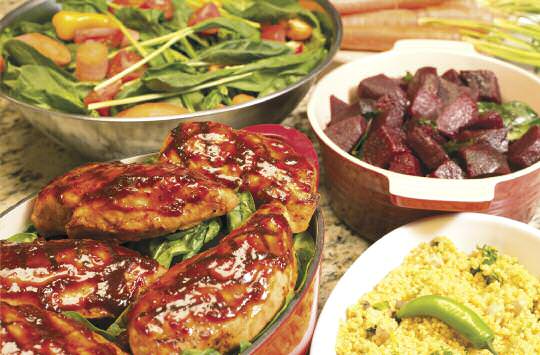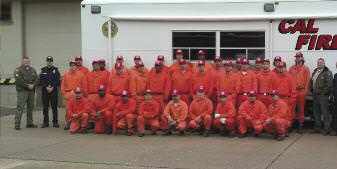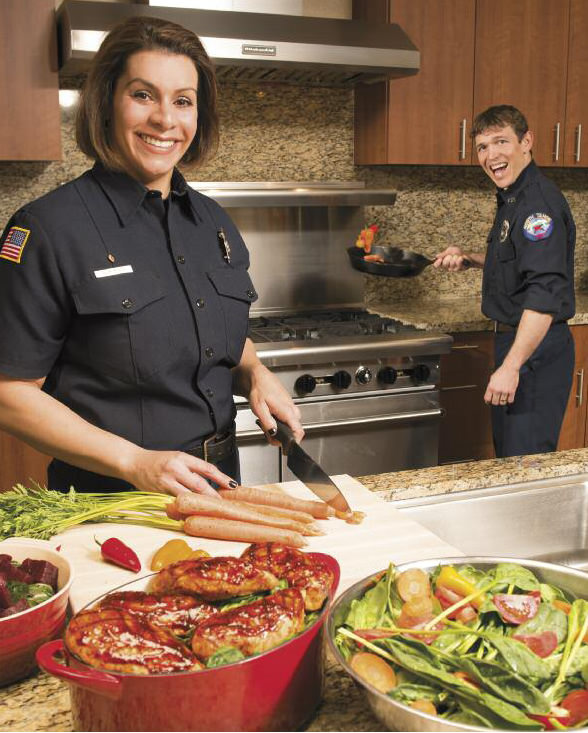cover
FEEDING THE FIRE
Edible Reno-Tahoe takes a peek at Reno-Tahoe’s best firefighter-chefs.
WRITTEN BY ANN LINDEMANN
PHOTOS BY JEFF ROSS
A few avoid gluten, others are vegans, and many shun carbs, but all firefighters know that Code 7 often turns into Code 3, so don’t dilly dally at the dinner table. You see, in firehouse-speak, Code 7 means mealtime and Code 3 is a medical call. Understandably, firefighters must quickly adapt to this occupational code collision.
“You learn how to eat fast,” explains Tim Spencer, division chief of the Reno Fire Department. “One of the biggest challenges is being able to finish your meal, especially in a busy firehouse. It’s not uncommon to reheat your dinner four or five times.”
While these everyday heroes may not always have time to slowly savor their meals, it surely doesn’t mean that they don’t appreciate a tasty workday repast. Case in point is the typical firehouse morning meeting at the start of each 48-hour shift. After the important work and training details are ironed out, the second order of business is meals for the four- to eight-person crews.
Generally, one firefighter takes the lead as shift chef, while the others join in on the shopping and prep chores. Then everyone contributes to the mealtime kitty; the typical per-meal cost ranges from $5 to $10. It’s important to note that these meals are funded by the firefighters themselves. Not surprisingly, they strive to keep costs down whenever possible. Some crews design their meals around the weekly grocery store circulars. If there’s a killer deal on tri-tip, then tri-tip will find its way onto the firehouse menu.
And just as a Code 3 can interrupt a Code 7, shopping trips often are derailed by emergency calls. As such, firefighters develop an understanding with supermarket staffers, who kindly set the carts aside until the crew returns.
Despite these challenges, this time-honored firehouse mealtime tradition endures. When not saving lives and structures, these firefighters are blowing off steam and building camaraderie by preparing and (ultimately) sitting down to firehouse “family” meals. Indeed, many basic firehouse cuisine techniques can easily translate to any family meal.
As in traditional families, firehouse family members don’t mince words when it comes to critiquing food quality. Therefore, a firehouse chef must have both a great sense of humor and a tough skin.
Like the shiny apparatuses that are housed below, firehouse kitchens have come a long way with industrial six-burner stoves, double ovens, and always three separate refrigerators to accommodate each shift.
Here we meet some of the region’s best firehouse chefs: three guys and one gal who can take the heat and aren’t afraid of the kitchen — at home or at the firehouse.
Barbecue Thigh Master
It’s a warm spring evening at the Reno Fire Department’s Station 3 and a delectable barbecue aroma is distracting everyone in its path.
Jason Belton (aka “JB”) swings the firehouse door open, skips formal introductions, and cuts to the chase, saying: “I hope you know you are staying for dinner.” Indeed, no one with a set of nostrils and taste buds could resist this guy’s command/invite.
Upstairs in the kitchen, a big batch of firehouse barbecue sauce is simmering away, and fellow crewmembers amble in, drawn to the aroma like moths to a flame.
“This is classic Reno fire food here,” Belton says. “You call any station you want and there’s usually someone cooking it that night. It’s not my recipe; I think the base recipe started with a retired Reno firefighter named Jim Colombini.”
The sauce is an essential ingredient in Belton’s legendary chicken thighs. As he makes the finishing touches on the entrée, other firefighters pitch in by preparing a restaurant-worthy spring salad with dried cranberries and blue cheese, topped with homemade balsamic dressing.
It’s no surprise that in his pre-firefighting days, Belton, 43, considered a culinary career.
“I attended the Culinary Institute of America for one semester, but it was way too expensive at $6,000 per semester,” recalls Belton, who has been fighting fires now for 15 years, 10 of those with the Reno Fire Department.
After one aborted Code 7 attempt, the crew eventually regroups around the firehouse table and discusses the job’s challenges and rewards. This particular shift prides itself on having a high degree of cohesiveness that not all crews possess.
“We share one brain,” jokes firefighter Rick Canaday.
And some might argue that these guys have one stomach as well.
“We eat together because it helps to develop trust among us,” Belton explains. “It’s important due to the fact that our job is so dangerous at times and we greatly depend upon each other.”

Up-and-Coming Firehouse Chef
North Tahoe Fire Protection District firefighter Scott Worl might not be at the top rung of the fire department seniority ladder, but that doesn’t stop him from jumping into the kitchen.
“I like making food that’s interesting,” says Worl, 35. “I try to be creative and mix it up, but I try not to go too far out of the box.”
Worl has been with the NTFPD for five years, but just recently became a full-time firefighter/paramedic. He recalls a recent gastronomic trial by fire at the firehouse.
“It was my first Christmas working here, and I was just getting the hang of things,” Worl remembers. “We were making prime rib, and when it was in the oven, someone leaned on the button and turned the oven off. Needless to say, it was a late dinner.”
Worl admits that, for him, cooking is a recently adopted skill.
“My mother wouldn’t even let me in the kitchen,” he says while expertly doling out a fragrant roasted chicken with lemon, garlic, and fresh rosemary.
When conjuring up ideas for firehouse meals, Worl tries to keep it simple. Much of his advice easily can translate to home cooks. His go-to favorites are apt to start on the grill or in a slow cooker.
“Find a cookbook that has simple recipes and only uses a few ingredients,” Worl says. “Get to know the crew and what they like. I try new recipes that I think everyone will enjoy and that will challenge me in the kitchen.”
Adapting to Diverse Tastes
Forty-three-year-old Jason Gibeaut has been a firefighter for a decade and a dad for even longer. As a chef, he understands one must be flexible and adapt to a crew’s gastronomic idiosyncrasies — whether it’s his firehouse family or his family at home.
“It’s just like any group of people living together,” he explains. “Everyone has (his or her) likes and dislikes. And you have to pay attention to what people are allergic to. I remember one dinner I made and the main ingredient turned out to be something that one guy was highly allergic to.”
Gibeaut admits that whether it’s at work or at home, it’s “hard to create something that everyone will like.”
To address this challenge, Gibeaut likes to create meals that folks can adapt to their unique needs.
“A favorite is fajitas,” he says. “I’ll start with a really good base, like a nice marinated chicken on the grill. Then the guys can choose what to add. For instance, if you don’t like olives, you don’t have to put olives on.”
He says firefighters at Northstar always have been fairly health conscious when it comes to eating, but there have been some changes through the years.
“Different diets have definitely dictated how I cook now,” Gibeaut says. “Everyone is super conscious of carb-cutting, and lots of guys are following a paleo diet.”
At Gibeaut’s Truckee firehouse, the crew also enjoys frequent breakfasts together.
“I’ve noticed that the guys are more into healthy smoothies than lots of pastries,” he observes.
Type-A Chef
Rosa Myers, 36, selected her current career after observing firefighters in the emergency room, where she worked as an emergency medical technician. Myers was intrigued by the idea of “never doing the same thing twice.” It’s an ethos that soaks into every aspect of her life, whether it’s cooking for Station 21 firefighters, inventing a wrist protector for CrossFitters, or taking on a side job as an aesthetician.
“I guess you could say I’m a Type-A person,” Myers says.
This dark-haired dynamo says that she’s definitely had to adapt both her firehouse cooking and her firehouse eating during her 10-year tenure with the Reno Fire Department.
“I remember so clearly, in the beginning, I was accustomed to burning a lot of calories, and then I started at a station that was not as busy,” she says. “We had these big firehouse portions and there was almost a pressure to eat. I started to gain weight, little by little. I finally said, ‘Hey guys, I can’t do this anymore,’ and everyone was cool with it. In fact, there were many who said ‘Yeah, I should be cutting back, too.'”
Myers learned about portion control; instead of firehouse platters, she now opts for normal-sized plates. And she says it’s not that hard to nudge the health dial on firehouse favorites.
“For the last two years, I’ve been making chocolate chip cookies for the crew,” Myers says. “Recently, everyone has gone paleo, so I changed the cookie recipe. I just tweaked it a little and there were no complaints.”
These culinary tweaks continue into other firehouse meals. Pasta — the perennial firehouse favorite — now is replaced with healthier spaghetti squash. And that juicy hamburger and French fry lunch that everyone craves from time to time? Well, that’s been replaced by turkey burgers and sweet potato fries.
Myers, a mother of two, believes “family” magic happens at mealtime … be it at home or the firehouse.
“I think it’s the whole aspect of bonding,” she says, “because it’s never just one person cooking. There will be one person making the salad, while another person is chopping the onions. The kitchen is a powerful place and it brings everyone together. And then, sitting down to dinner, you get to hear people talk about their families and all sorts of family memories. It’s really neat.”
Writer Ann Lindemann enjoyed riding along with the Reno Fire Department Station 3 crew and dousing a training fire with the North Tahoe Fire Protection District crew. And now, when beckoning her family at dinnertime, Lindemann yells: “Code 7!”
Recipe
Firehouse Barbecue Sauce
(courtesy of Jason Belton. Makes about 4½ cups of sauce)
3 cups ketchup
1 1-pound box dark brown sugar
½ cup apple cider vinegar
½ cup Worcestershire sauce
1 tablespoon whole celery seed
Combine all ingredients in a saucepan and simmer over low heat for 10 minutes. After completely cooking skinless chicken thighs on the grill, brush the sauce on them and bake on a foil-lined pan for 5 to 10 minutes at 425 degrees F.
Rosa Myers’ Turkey Burgers
(Makes 6 large burgers)
1 16-ounce tube hot chicken sausage
1½ pounds ground turkey
1 to 2 cups Italian breadcrumbs
1 egg
Seasonings, to taste: salt, pepper, granulated garlic, cumin, parsley
Preheat grill so that it’s nice and hot.
Mix all meat products together, then seasonings and egg. After the egg, mix in the Italian breadcrumbs.
Use cooking spray on grill, and cook burgers for 20 to 25 minutes. Top burgers with your favorite vegetables.
Siren Sauce
Answering a spicy call.
Drizzled on pizza, splashed in soup, or liberally sprinkled on eggs, hot sauce has long been a Reno firehouse favorite.
“I don’t know who started to make it first, but it’s been a standard condiment at Reno firehouses for as long as I’ve been around,” explains Tim Spencer, the Reno Fire Department division chief.
Spencer says that firehouse chefs all put their own twists on the sauce, but as an avid chef, he took a special interest in this classic condiment. This was something that did not go unnoticed when friend and fellow chef, Gino Scala of Great Full Gardens Café and Eatery in Reno, stopped by the Spencer house for some wood-fired pizza.
“I said, ‘Hey, you gotta try some of this sauce on your pizza,’ and he fell in love with it,” Spencer recalls.
So enamored with the sauce, Scala begged for the recipe and now serves it at his popular Reno café. Originally dubbed Lava Sauce, the savory, flavor-enhancing condiment is now aptly named Siren Sauce.
Spencer says the customer response has been so positive that he now has plans to bottle and sell it commercially.
“It’s not the kind of spicy sauce that makes you sweat,” he says. “It’s more of a nice, slow burn that’s smoky from the roasted peppers that we use.”
While commercial distribution still is in the works, those who want to get their ‘slow burn’ on will have to settle for a visit to Great Full Gardens Café to try it.
Feeding Wildland Fire Crews
Last summer 5,000 brave firefighters fought the third largest wildfire in California history, the Yosemite Rim Fire. So you might wonder, in such a remote location do these hardworking guys and gals subsist on survivalist type fare? Not quite, says Paul Gaines, Cal Fire fire captain.
“A typical meal could be a steak, baked potato and a salad bar,” Gaines explains. “It’s not super fancy, but it’s not dehydrated.”

Located in Georgetown, Calif., the Cal Fire Growlersburg Camp is a key player in forest firefighting operations in Northern California. This station is responsible for two mobile kitchens that are dispatched to remote sites with everything to serve nutritionally balanced meals from start to finish. The larger mobile kitchen unit can serve up to 2,500 meals and the smaller food-dispensing unit can dole out 500 meals.
“From the time the MKU is ordered by the Emergency Operations Center to the time they are serving hot meals is about six to eight hours,” Gaines says. “For the FDU there is between three and four hours, plus travel time from the Growlersburg Camp. Sack lunches are also available for up to 1,000 lunches in under five hours.”
Inmate crews staff these mobile kitchen units, which run 24/7 during emergency situations such as the Rim Fire.
And does meal service ever come to a screeching halt when the fire takes an unexpected turn?
“You bet,” Gaines says. “It has definitely happened before. It’s all about safety for all involved.”


